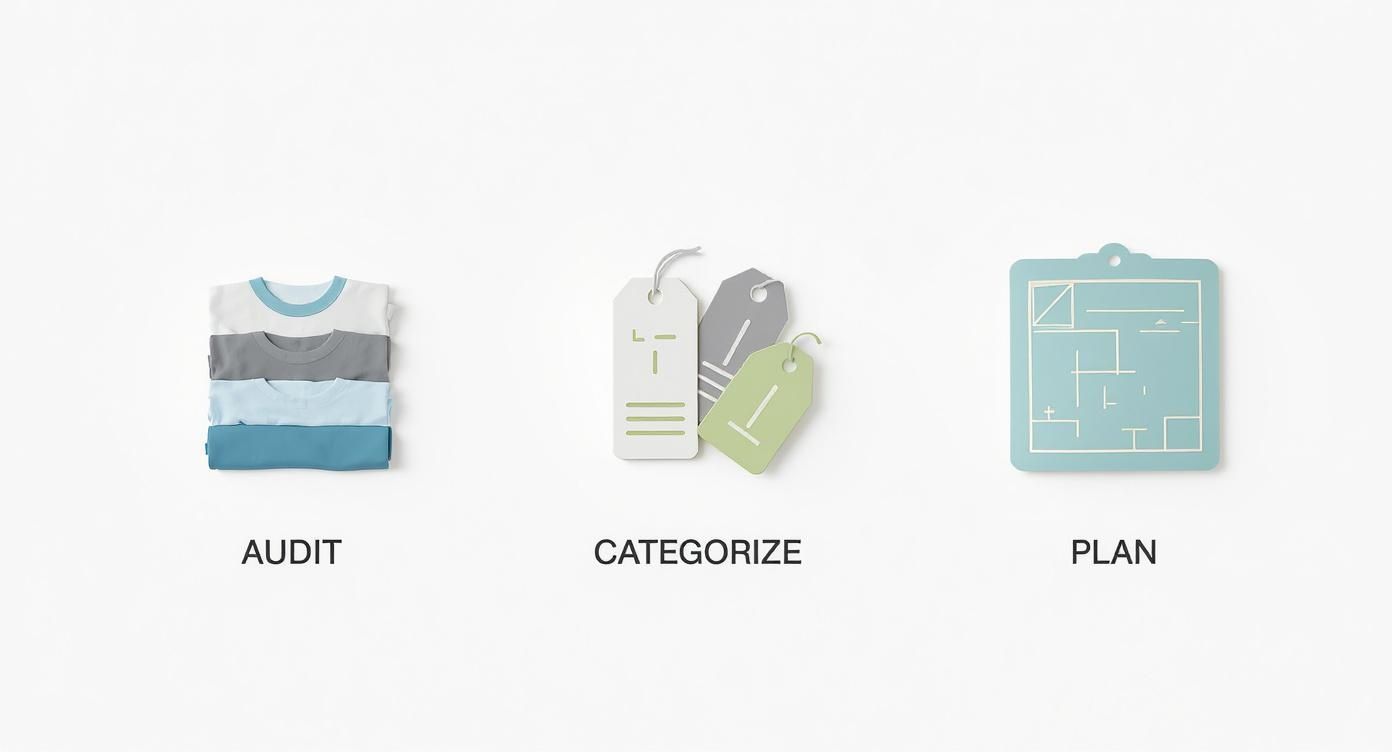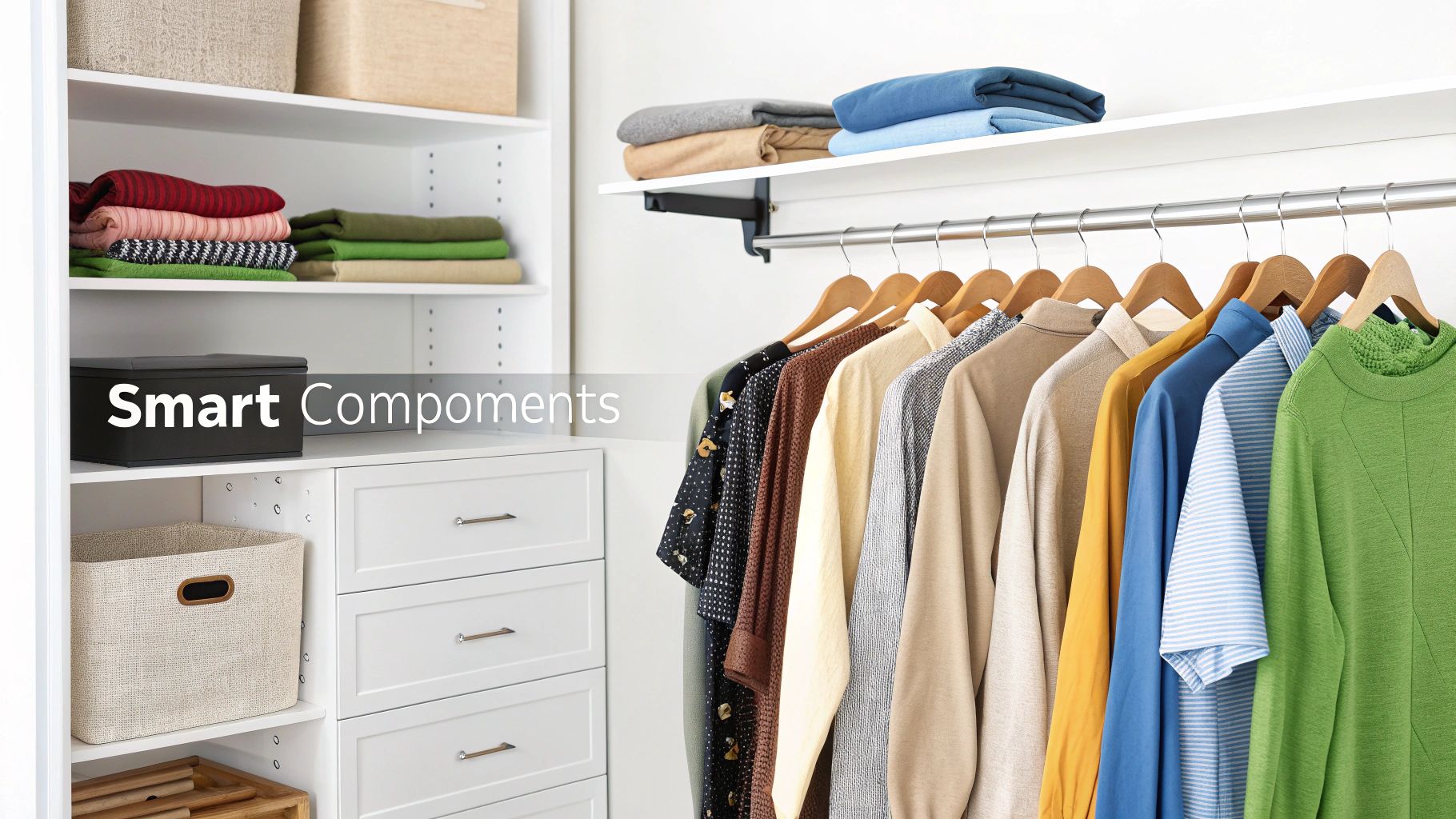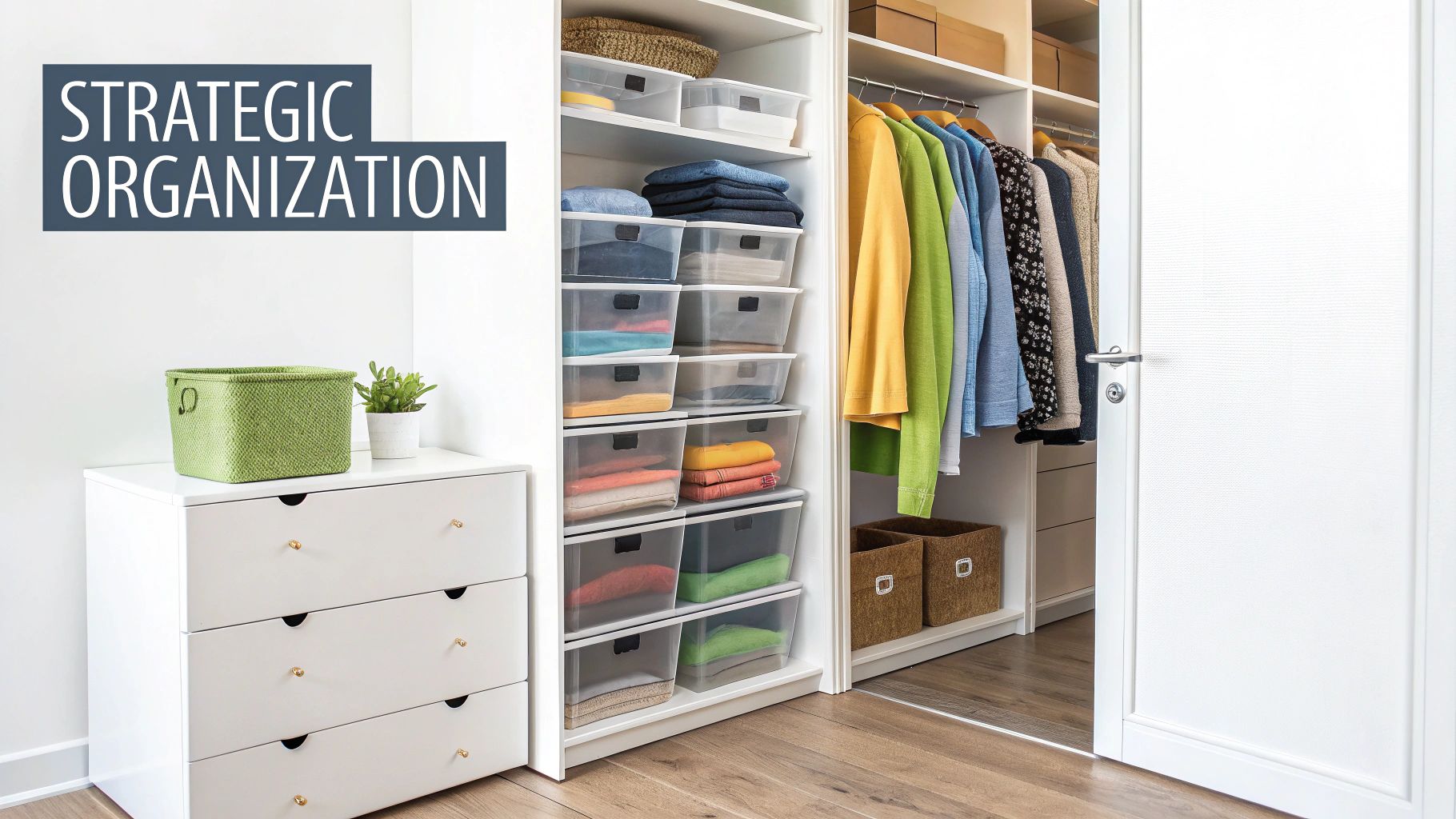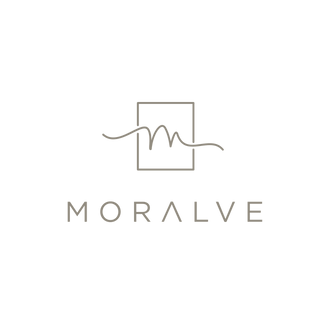Design a Closet System for Perfect Organization

Before you even think about grabbing a tape measure, the real work of designing a killer closet system begins with your clothes. It’s a common mistake to jump straight to the physical space, but the most functional closets are designed from the inside out—starting with your actual wardrobe and daily habits. The goal is to build a highly organized space where everything has a home.
This approach ensures the final design is built for your life, not just for the four walls it occupies.
First, Take Stock of Your Wardrobe
I’ve seen it time and time again: people design a beautiful closet that just doesn't work for them. Why? Because they focused on the space's dimensions instead of their personal inventory. A closet that looks great but makes getting dressed a chore is really just well-organized chaos. The whole point is to create a system that feels completely intuitive.
This initial audit is more than just counting your shirts. It's about spotting the patterns in your lifestyle and translating them into smart organizational solutions. Think of your wardrobe as a few different collections, each serving a unique purpose.
What Are Your Real Clothing Categories?
Forget generic labels like "tops" and "bottoms." To build a closet that actually helps you, you need to organize it based on how you live your life. This is the foundation of a good closet organization strategy.
Think about segmenting your clothes by function. For instance:
- Daily Workwear: What do you reach for Monday through Friday? If it’s mostly suits, you'll need plenty of long-hanging space. If it's blouses and slacks, a double-hang rod system is far more efficient.
- Weekend Casual: This is your comfortable stuff—jeans, t-shirts, and cozy sweaters. Many of these items are perfect for folding, which means shelving or drawers are your best friends here.
- Activewear & Loungewear: Let's be honest, gym clothes and sweatpants can become a tangled mess. Giving them their own dedicated, easy-to-access spot is a game-changer for closet organization.
- Formal & Occasion Wear: That cocktail dress or tuxedo doesn't need to be front and center. These items often require protective storage or a specific long-hang section, tucked away from your everyday rotation.
- Seasonal Items: Bulky winter coats and heavy knits can hijack valuable closet real estate. Planning a designated spot for off-season storage is key to keeping your main space organized and functional all year.
A closet built around your lifestyle just works better. When your "work uniform" has its own dedicated zone, you aren't sifting through weekend t-shirts at 7 AM on a Tuesday. This simple shift is the difference between a closet that just looks organized and one that truly feels organized.
Turn Your Inventory into a Smart Storage Plan
Once you’ve defined your categories, you can figure out what kind of storage you actually need. This is where your audit pays off, directly shaping the design. For example, if you find that 80% of your work clothes are blouses you prefer to hang, you'll know to prioritize rod space over shelves. Or, if you have a huge collection of folded jeans, deep drawers suddenly become a non-negotiable feature for organization.
This kind of proactive, personalized planning is exactly why the custom closets market is booming. Valued at USD 29,319.2 million, it's projected to hit an incredible USD 59,124.34 million by 2033. People are tired of one-size-fits-all solutions and are demanding systems designed specifically for their needs.
Of course, the first step in this whole process is often the hardest: decluttering. Before you can organize, you have to edit. Our guide on how to declutter your closet walks you through paring down your wardrobe to only the things you truly love and wear.
This makes the inventory process way less overwhelming and guarantees you’re building a home for the clothes you actually want to keep. By starting with a clean slate, you're not just organizing your closet—you're designing a system that supports your best self, every single day.
Map Your Space to Maximize Every Inch
Once you've sorted through your wardrobe, it's time to get intimately familiar with the closet itself. A great design is built on solid, accurate measurements. I can't tell you how many times I've seen a project get derailed by a simple half-inch mistake.
Think about it—that tiny error could be the difference between a drawer that opens smoothly and one that smacks into the door frame every single time. Taking the time to be meticulous now saves you a world of frustration later on. This is about creating a precise map of your closet's unique terrain, quirks and all, to ensure maximum organization.
Measure Everything, Then Measure It Again
Grab a good tape measure and a place to jot down your numbers—a notebook or even a note on your phone works fine. The golden rule here is to measure everything twice. Trust me, walls and floors are almost never perfectly level or straight.
- Total Wall Width: Measure the back wall's width at the top, middle, and bottom. Don't be surprised if the numbers are slightly different. Always use the smallest of the three as your final number.
- Total Height: Do the same for the height. Measure from the floor to the ceiling on the left side, in the middle, and on the right. Again, stick with the smallest measurement.
- Total Depth: Check the depth from the back wall to the closet opening on both sides. This number is crucial for knowing if you have enough room for deeper elements like drawers or pull-out shoe racks.
With these core dimensions in hand, you can start hunting for obstructions. These are the little details that are so easy to forget but can cause the biggest installation headaches.
One of the most common mistakes I see is people only measuring the usable wall space. You have to account for every single thing inside that closet's footprint—outlets, window trim, you name it. This detailed "space map" becomes your blueprint for a perfect fit.
Identify and Map Every Obstacle
Next, draw a quick sketch of your closet layout. It doesn't need to be a work of art; a simple box will do. This is where you'll mark the exact location and size of every potential roadblock.
This simple act of mapping out your space visually is what ensures the components you choose will fit seamlessly into the final design.

This process—from inventory to blueprint—is the secret to a closet that works just as beautifully as it looks.
Before you start planning, make sure you've got a handle on all the critical measurements and potential obstacles. I've put together a checklist to help you capture every important detail.
Essential Closet Measurement Checklist
| Measurement/Check | Why It's Important | My Measurement (Inches) |
|---|---|---|
| Wall Width (Top, Middle, Bottom) | Walls are rarely perfectly straight; the narrowest point is your true width. | |
| Height (Left, Middle, Right) | Ceilings and floors can slope; the shortest point is your true height. | |
| Depth (Left & Right) | Determines the maximum depth for shelves, drawers, and accessories. | |
| Door Swing & Clearance | Inward-swinging doors can block access to drawers or pull-outs. | |
| Baseboard Height & Depth | Floor-mounted units must fit inside the baseboards, not on top of them. | |
| Light Fixture Location | Prevents shelves from blocking light or making bulb changes impossible. | |
| Outlets & Switches | Ensures all electrical points remain accessible and usable. | |
| Attic/Crawl Space Access | Keeps critical access panels from being permanently blocked by the system. | |
| Sloped Ceilings / Soffits | Defines the usable vertical space and may require angled cuts or custom units. | |
| Window Casings / Trim | Any trim around windows will reduce the available wall space for components. |
Taking the time to fill this out thoroughly is the best way to guarantee that the system you design on paper translates perfectly into reality. This meticulous approach sets you up for a smooth installation and a closet that truly maximizes every single inch you have.
Choose Components That Fit Your Lifestyle
Alright, you've done the hard work. You have a precise map of your closet and you know exactly what’s in your wardrobe. Now for the fun part: picking out the hardware that will bring your dream organized closet to life. This is where all that planning really pays off, because every choice you make from here on out will be based on your real needs, not just what looks good in a showroom.
This isn't just about tidying up; it's a genuine lifestyle upgrade. There's a reason the global closet organizer market, currently valued at USD 12.5 billion, is expected to jump to USD 19.8 billion by 2032. More and more people are realizing that a closet designed for their life brings a sense of calm and efficiency to their daily routine. You can see more details in the latest closet organizer market research.

Translate Your Wardrobe into Hardware
That wardrobe audit you did earlier? It's now your shopping list. Let's look at how to match your clothing categories with the right closet components for a setup that is perfectly organized.
-
Got a lot of shirts and blouses? If your inventory revealed dozens of button-downs, slacks, and tops, a double-hang rod system is essential. This one move instantly doubles your hanging space. You get one rod for tops and another for bottoms, making it the single most effective way to use the vertical real estate in your closet for shorter garments.
-
Are you a sweater person? A mountain of knitwear is a common sight, but hanging sweaters is a recipe for stretched-out shoulders. The perfect solution is shelving. Aim for shelves that are 12 to 14 inches deep—this gives you enough room for neat stacks where you can see every item, preventing anything from getting lost in the back.
-
What about all that denim? Jeans are another item that does best when folded. If you have a sizable collection, think about using deep drawers or open cubbies. Drawers are great for keeping them contained and dust-free, while cubbies give you that clean, retail-store look.
Your clothing tells you what it needs. A closet full of dresses demands long-hanging space, while a collection of activewear is better served by drawers and bins. Listen to your inventory—it's the blueprint for your organizational component choices.
Don't Underestimate Specialized Organizers
Beyond the basic rods and shelves, it's the specialized accessories that take a closet from good to great. These are the problem-solvers that tackle specific storage headaches and make your system incredibly efficient and organized.
One of the most powerful changes you can make involves your hangers. Think about it: bulky plastic or wooden hangers can easily eat up 25% or more of your rod space. Simply switching to a slim, non-slip design is like instantly adding another foot of room. To see how much of a difference this can make, check out our complete guide on the best space-saving hangers.
Consider adding other specialized tools based on what you own:
- Drawers for Small Items: Nothing creates clutter faster than socks, underwear, and accessories. Drawers are the best way to contain this chaos. Pop in a few dividers and you can create specific homes for everything.
- Pull-Out Racks: If you have a collection of belts, ties, or scarves, a pull-out rack is a game-changer. It keeps them organized and visible without them getting tangled in a drawer.
- Smart Shoe Storage: Give every pair a home off the floor. Angled shelves work beautifully for heels, flat shelves are perfect for boots, and cubbies are great for sneakers and casual shoes.
Picking Your Materials and Finishes
Finally, let’s talk materials. While you want your closet to look good, you also need it to last. Your choice here will come down to balancing aesthetics, durability, and your budget.
Here’s a quick rundown of the most common options:
- Laminate/Melamine: This is the go-to for a reason. It's budget-friendly, tough, and a breeze to clean. It also comes in a massive range of colors and wood-grain finishes, giving you a clean, modern look without the high price tag.
- Solid Wood: If you’re aiming for a high-end, traditional feel, you can't beat solid wood. It's incredibly strong and can be customized with any stain or paint. The trade-offs are a much higher cost and potential for warping in humid climates.
- Wire Systems: This is usually the most affordable option. Wire systems offer fantastic ventilation and are super easy to adjust. On the downside, the look isn't for everyone, and smaller items can sometimes fall through the gaps.
By thoughtfully picking each component based on your personal inventory, you're building a system that’s perfectly tailored to your life. This is the step that turns a plan on paper into a closet that works for you every single day.
Master the Art of Strategic Organization
Putting in a beautiful new closet system is a great first step, but it’s only half the battle. The real magic happens when you start filling it up with a clear plan. Without a smart organizational strategy, even the most perfectly designed closet can quickly descend into chaos. This is where you transform a simple collection of shelves and rods into a living, breathing system that makes your daily routine feel effortless.
This isn’t just about storing your stuff; it's about creating a logical flow for your belongings. Everything needs a home so you can find it in seconds. We're moving away from simply stashing clothes and toward actively managing your wardrobe for peak organization.

Create Zones That Fit Your Life
By far, the most effective organizational trick I've learned is zoning. Think of your closet as a small, highly efficient map of your life. Each zone serves a specific purpose, which completely eliminates the guesswork when you're getting ready in a hurry. Instead of having one giant, overwhelming section for "shirts," you'll create micro-zones that actually reflect your day-to-day needs.
Different lifestyles call for different closet maps. Someone who works from home will have a vastly different setup than a corporate executive who travels for business. The key is to design zones that cater directly to your routine.
Here’s a look at how you can tailor your closet zones based on your specific wardrobe and daily demands.
Closet Zoning Strategy Examples
| Zone Type | Best For | Key Components & Accessories |
|---|---|---|
| The 9-to-5 Professional | Individuals with a corporate or office-based job. | Prime real estate for work attire. Group blouses, slacks, and blazers. Use slim velvet hangers to maximize space and tiered hangers for pants. |
| The Weekend Warrior | Anyone whose wardrobe is primarily casual and comfort-focused. | Easy-to-grab items. Open shelving for folded jeans and sweaters, hooks for jackets, and drawers with dividers for t-shirts. |
| The Fitness Enthusiast | People with a large collection of activewear for the gym, yoga, or sports. | Ventilated storage. Dedicated cubbies or drawers for leggings, sports bras, and tops. A separate hamper for workout clothes is a must. |
| The Social Butterfly | Those who frequently attend events and have a distinct "going out" wardrobe. | Protect and preserve. Use a higher, less-accessible rod for formal dresses and suits. Garment bags are key. Add shelving for clutch purses and special occasion shoes. |
This approach is so powerful because it mirrors how you actually think. You don't just look for "a top"; you look for "a top to wear to the gym" or "a blouse for my meeting." Zoning makes your closet organization completely intuitive.
If You Can't See It, You Won't Wear It
There’s a simple truth in closet organization that I live by: if an item is hidden, it might as well not exist. Opaque bins and deep, cluttered drawers are black holes where perfectly good clothes are forgotten. To get the most out of your entire wardrobe, you have to make everything as visible as possible.
This is exactly why open shelving and clear containers are your best friends. When you can scan your entire collection of sweaters on a shelf at a glance, you're far more likely to rotate through them. The same goes for shoes—using clear boxes or angled shoe shelves means you won't default to the same three pairs over and over again.
By making your items visible, you create a "shop your own closet" experience every single morning. You’re constantly reminded of all the great pieces you own, which sparks more creative and varied outfits.
This desire for smarter, more efficient storage is what's driving major trends in the home organization market. The global reach-in closets market, currently valued at USD 2.8 billion, is projected to hit USD 4.7 billion by 2033. People are tired of the chaos and want systems that work. You can check out more on how customized closet systems are evolving and what’s driving this growth.
Go Vertical and Fold Smarter
To really squeeze every bit of utility out of your closet, you have to think vertically. Most people only plan horizontally across rods and shelves, but the real untapped potential is in the height.
- Shelf Dividers: These are lifesavers. Pop them onto a shelf to keep stacks of sweaters or jeans from morphing into one messy, leaning tower. They create neat, tidy lanes.
- Tiered Hangers: This is where you get huge returns on space. Hangers like MORALVE’s multi-pant or skirt hangers let you hang several items in the vertical space of a single hanger. It’s an absolute game-changer for closet organization.
- File Folding: Stop stacking clothes in your drawers. Instead, use the file folding method. Fold items into small rectangles and "file" them from front to back. You'll be able to see everything in the drawer at once without digging.
Learning even a few of the best ways to organize clothes can make a lasting difference. A well-organized closet isn't a one-and-done project; it’s a set of habits. By building these smart systems from the start, you ensure your closet stays functional and beautiful long after the initial setup.
Bring Your New Closet to Life: Installation Day
You've done the hard work of measuring and planning, and now it's time for the fun part—making it real. Installing your own closet system can feel like a big job, but don't let that intimidate you. Think of it as building a high-end piece of furniture that's about to completely change how you start your day. Let's walk through how to get that sturdy, professional finish you're after.
https://www.youtube.com/embed/P9QrjjOY29M
Prep Your Tools and Your Space
The secret to a frustration-free installation is getting everything ready before you open a single box. Trust me, you don't want to be scrambling for a drill bit with a half-installed shelf in your hands.
Gather your essentials first. You'll definitely need:
- A trusty tape measure for double and triple-checking.
- A good level (a 24-inch one is perfect for this) to keep things straight.
- A stud finder. This is absolutely critical for a secure installation.
- A cordless drill with a full set of bits.
- A pencil for all your wall markings.
Laying all your tools out where you can easily grab them will make the whole process smoother and far less chaotic. A little prep now saves a lot of headaches later.
A Smart Assembly Strategy
Where you start makes a huge difference. I’ve learned from experience that it's always best to install the biggest, most structural pieces first. This creates a solid foundation you can build everything else around. For most systems, that means either hanging the main vertical panels or assembling the central tower units.
If you have floor-based drawer units in your design, start with those. It's so much easier to build them in an open space outside the closet and then move them into position. Once they're in place, you have a physical anchor to measure from as you install the rest of your system.
With the main structures up, the rest of the job feels more like putting a puzzle together. Next, hang the horizontal rails that will hold your shelves and closet rods. This is where your level is your best friend—use it on every single piece. Don't just eyeball it. A tiny slant can look like a major mistake once the whole closet is finished.
Avoiding Common Installation Traps
Even with a perfect plan, you can hit a few snags. The biggest rule of thumb? Always anchor into studs whenever you possibly can. While drywall anchors have their place for lighter items, the main supports carrying the weight of your wardrobe need the security that only a wall stud can provide.
Another common surprise is discovering your walls aren't perfectly straight. Don't panic if you see gaps behind your units.
Almost no home has perfectly plumb walls. A classic mistake is trying to force the system flush against a bowed wall, which can twist the components and make drawers bind. The right way is to secure the unit to the studs, then use small shims to fill any gaps for a level and stable fit.
Finally, don't skip the finishing touches. After the system is assembled and secured, go back and pop the cover caps into any visible pre-drilled holes. It's a small detail, but it's what makes a DIY project look truly professional. This extra bit of care is key when you design a closet system built to last. With a little patience, you'll have a closet that works beautifully and looks like it was installed by a pro.
Answering Your Top Closet Design Questions
Even the most carefully laid plans run into snags. When you're in the middle of designing a closet, a small question can feel like a major roadblock. Let's tackle some of the most common hurdles I've seen people face, so you can get unstuck and finish your project with confidence.
What if a Standard System Doesn't Fit My Space?
This happens all the time. Your closet's dimensions rarely match the exact sizes of off-the-shelf systems, especially in older homes. If you've got an awkward nook or a weird width, the last thing you want to do is try to jam something in that doesn't belong. The whole point is to make the space more organized and efficient, not just fill it.
The best approach is often to combine different system widths to get as close as you can to a perfect fit. For any leftover gaps, a simple filler strip or a small, custom-cut shelf works wonders. Just paint it to match your units, and it'll look like a seamless, built-in feature instead of a mistake. Plus, no more dust bunnies hiding in weird gaps.
Drawers vs. Shelves: Which Is Better?
There’s no single right answer here—it all comes down to what you discovered during your wardrobe audit. Neither is "better," they just do different jobs for your closet organization.
- Shelves are for visibility. They're perfect for things you want to grab quickly, like bulky sweaters, neatly folded jeans, or bins holding accessories. If you can see it, you're more likely to use it.
- Drawers are for controlling the clutter. They’re your secret weapon for small items that can easily become a jumbled mess—think socks, underwear, workout clothes, and pajamas. They keep the visual noise tucked away.
A good way to decide is to put anything you want to see at a glance on a shelf. Everything else that doesn't stack well or looks messy can go into a drawer.
I see a lot of people just replicate their old, frustrating setup. But this is your chance to fix what never worked! If you’ve always hated digging through a messy T-shirt drawer, try file-folding them on a shelf instead. It's a tiny change that can honestly make your morning routine feel so much smoother.
Is It Okay to Mix Different Kinds of Storage?
Not only is it okay—it’s essential! The most functional and organized closets are the ones that blend different storage types to create a truly efficient system. The best designs I've seen often have a section of double-hang rods for shirts and pants, a bank of deep drawers for knitwear, and a tower of shallow shelves for shoes, all in the same space.
Think of it like creating a custom toolkit for your clothes. Each component has a specific job. Mixing and matching is how you ensure that every single thing you own, from a heavy winter coat to a delicate silk scarf, has a practical and easy-to-access home. That’s the real goal when you design a closet system.
Ready to transform your closet from cluttered to calm? MORALVE's innovative space-saving hangers are the perfect finishing touch to any new closet system, instantly maximizing your hanging space. Discover the collection and start your organization journey at https://moralve.com.


Leave a comment